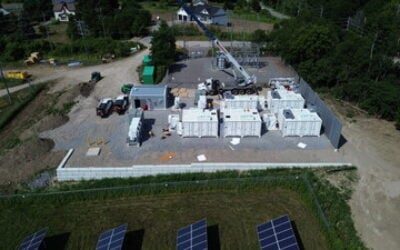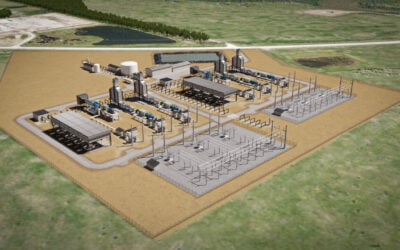
Energy Storage Canada (ESC) is “thrilled” that the Canada Infrastructure Bank’s (CIB’s) loan for a large-scale battery storage portfolio will enable Indigenous communities to hold a stake in it.
Justin Wahid Rangooni, executive director of national trade association ESC, commented on the Crown Corporation vehicle for investing in infrastructure’s CA$138.2 million (US$101.82 million) commitment to three projects in the Atlantic Canadian province of Nova Scotia.
CIB announced the investment in mid-February, marking the first commitment to date under the bank’s Indigenous Equity Initiative. The scheme aims to enable First Nation, Métis, and Inuit communities to hold ownership stakes in projects that CIB is also investing in.
“ESC is thrilled the CIB’s first Indigenous Equity Initiative loan is part of the largest battery storage investment in Atlantic Canada to date,” Rangooni told Energy-Storage.news yesterday.
Try Premium for just $1
- Full premium access for the first month at only $1
- Converts to an annual rate after 30 days unless cancelled
- Cancel anytime during the trial period
Premium Benefits
- Expert industry analysis and interviews
- Digital access to PV Tech Power journal
- Exclusive event discounts
Or get the full Premium subscription right away
Or continue reading this article for free
“Equitable partnerships with indigenous communities and securing their active participation in the modernisation of Canada’s grids, including the integration of energy storage, will be key to achieving Canada’s net-zero goals and ensuring a sustainable future for all Canadians.”
CA$130 million to come from federal government
The projects will be constructed in the communities of White Rock, Bridgewater and Waverley, each of 50MW and 4-hour duration (200MWh).
They will be built by Nova Scotia Power (NS Power), the main electricity supplier to the province. NS Power is state-regulated and not state-owned, being a subsidiary of shareholder-owned listed company Emera.
NS Power will get a loan of up to CA$120.2 million from CIB and a partnership between 13 First Nation Mi’kmaw communities called Wskijinu’k Mtmo’taqnuow Agency (WMA), which is working with the energy provider, will get an equity loan worth up to CA$18 million.
CIB said the Indigenous Equity Initiative lending will finance 90% of the Indigenous participation in the portfolio projects, contributing to the bank’s target of financing at least CA$1 billion-worth of projects that will benefit Indigenous communities in the country.
The initiative, launched in November last year, offers loans of between CA$5 million to CA$100 million per project.
While it may be CIB’s first loan to enable Indigenous participation in battery energy storage system (BESS) ownership, Canada’s biggest BESS project in development so far, the 250MW/1,000MWh Oneida project in Ontario, is being co-developed by the Six Nations of the Grand River First Nations community, on whose land it will be built.
NS Power has also secured a further CA$130 million towards the proposed project through Natural Resources Canada, the federal government department which has a remit that includes energy, minerals, and natural resources.
Energy storage developments in Canada have largely been focused on its two biggest provinces, Ontario and Alberta, to date. However, last summer Nova Scotia lawmakers determined that electricity storage will be a key pillar of the province’s transition from coal-fired power generation.
NS Power BESS plan suitable, Clean Energy Task Force finds
Among the regions of Canada most dependent on coal, national statistics showed that in 2019, 51% of Nova Scotia’s power generation came from the environmentally unfriendly fuel source.
The provincial Environmental Goals and Climate Change Reduction Act, signed into law in 2021, demands that usage cease by 2030. In October 2023, the Nova Scotian government said it would deploy between 300MW and 400MW of battery energy storage by 2030 in line with its clean energy plan. The government said this would help it harness the region’s abundant wind resources.
Patrick Bateman, an independent consultant affiliated with Energy Storage Canada, offered some more recent policy context to Energy-Storage.news in a commentary yesterday.
Nova Scotia’s Clean Electricity Solutions Task Force (CESTF), set up to implement goals including the coal phaseout and getting the province to 80% renewable energy by 2030, has recommended setting up an independent energy system operator (IESO), Bateman said.
The Nova Scotia IESO (NSIESO) would have duties that included removing any potential for the perception of bias in system planning, interconnection studies, or towards NS Power and Emera’s commercial interests, and implementing better and more efficient interconnection procedures.
The IESO would take on roles like integrated energy system planning, operating the grid and administering markets, in a similar way to how respective organisations in Ontario and Alberta take care of the electricity system in those provinces.
More specifically with regard to energy storage, the NSIESO would oversee the implementation of battery storage technology. The Task Force said that the plans to deploy up to 400MW of storage enjoyed “broad-based support”.
“The interconnection of these projects will provide system wide benefits, including: fast response for system disturbance; short term reserves an energy time shifting; and ongoing support of system balancing,” Task Force said in a statement.
“It is the view of the Task Force that the battery storage plans are being appropriately developed to serve the interests of Nova Scotians.”
Patrick Bateman was one of the interviewees for an article published in PV Tech Power (Vol.35) last year, focusing on how lessons learned in Canada’s two leading provinces, which account for more than 80% of the country’s announced energy storage deployments, could be transferred or otherwise learned from in other regions, including Nova Scotia and other Atlantic Canadian provinces.
Energy-Storage.news’ publisher Solar Media will host the 6th Energy Storage Summit USA, 19-20 March 2024 in Austin, Texas. Featuring a packed programme of panels, presentations and fireside chats from industry leaders focusing on accelerating the market for energy storage across the country. ESC’s Justin Rangooni will be among the speakers. For more information, go to the website.





